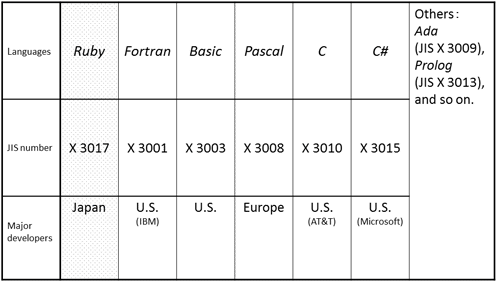Introduction
The year 2014 has begun. Looking back on 2013, we realize there were such bright spots as the designation of Mount Fuji as a World Heritage site and Tokyo's selection as the host city for the 2020 Summer Olympics. These events have given us a chance to rediscover that what Japan possesses is worthwhile. For 2014, a valid policy is to revitalize the economy by discovering the values of Japan's latent competitiveness (Note 1). In this column, I will discuss the significance of discovering the values by citing an example of how industrial technologies originating in Japan, in areas that are probably surprising for many people, have become globally competitive. The example is a programming language called Ruby, which has become an international standard.
Technological trends
Traditionally, development of programming languages has been done mostly in English-speaking countries. In particular, the main center for the development of major programming languages is the United States. For example, the language C was developed by AT&T Labs, Inc. and Java by the former Sun Microsystems, Inc.—both of which are U.S. companies. As is often said, if the most important British export is the English language (a natural language), the U.S. equivalent may be programming languages (artificial languages). This historic background has led to the geographical concentration of relevant technological information, which in turn has given a competitive advantage in computer technology to companies and research organizations located in the United States.
In addition, the languages used in building various information systems, including C and Java, are constructed based on English grammar and the definitions of English words, though there has been no explicit consensus or set of rules dictating this. This puts obstacles in the way of people in non-English-speaking regions who try to learn these programming languages. Development of a programming language that allows non-English-speaking workers to program using the knowledge of their native language, or Japanese in our case, would be ideal. However, technological advancement has already accumulated to a significant degree in the existing programs, indicating that developing such a language may not be realistic because it would present difficulties in establishing compatibility with them.
However, if a programming language is developed in Japan, even if it is not based on the Japanese language, and becomes an international standard, we can expect it to give Japan an advantage in programming technologies. You may ask if such a language really exists. Fortunately, it does, and it is the Ruby programming language developed by the Japanese. Ruby is proliferating as a system-building language for the Web. After it was accepted as a Japanese Industrial Standard in 2011, the Information-technology Promotion Agency (IPA) led the drive to make it a global standard. In 2012, it was accepted as an international standard by the International Organization for Standardization (ISO).[1], [2] In December 2013, the completion of a series of work on the standardization of Ruby was announced.[3] In academia, too, Ruby is being taught as part of liberal arts-level information education at Japanese universities, indicating its further penetration into society (Note 2).

As a fundamental-level technology, a programming language is likely to have a significantly positive effect on the promotion of industries, because once a system using that language is introduced, the language will be used for several years, and the need for maintenance and updates will generate demand for human resources. When standardizing an advanced technology, it is necessary, in building a business model, to consider the right balance between the areas of the technology disclosed for standardization purposes and those not subject to standardization and to remain secret. However, in the case of a programming language, such consideration is not necessary in disclosing the language specifications. In addition, a language originating in Japan is expected to reflect the needs of the Japanese industry when it is updated to keep pace with technological advancement.
Conclusion
In this column, I described how a fruit of Japanese development efforts in what might be an unlikely area of cutting-edge technology has become a global standard under Japan's initiative. I selected this example to illustrate the importance of discovering a value existing in Japan and making it a global standard. Technologies originated in Japan and that have a technological advantage such as Ruby may be found if we look around. Ruby is playing an important role in promoting Japanese industry and academia. I hope more discoveries will be made in terms of Japan's socio-cultural values and the values inherent in Japan's technologies, and that they will be re-evaluated this year, just like what happened last year, to help revitalize our society and economy.


